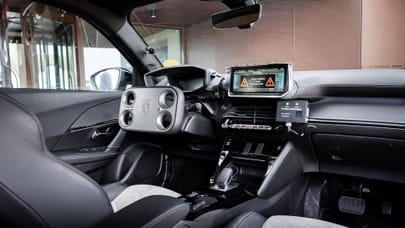
Hammond on the Highway Code of the sky
I have, as was mentioned on the show at the end of the last series, been messing about in helicopters a bit lately. Although ‘messing about' is hardly an appropriate epithet when applied to a creature seemingly capable of catapulting a person through the Pearly swing doors at the slightest whiff of silliness.
It's a small helicopter, but it is, well, a helicopter and dismissing a small helicopter as cute and harmless is like putting a Piranha down your trousers. But despite the looming sense that, along with me and my trainer, the cockpit hosts a third, baleful presence with a sickle and a skeletal grin, it has been a wonderful and thrilling challenge.
I have applied my tatty little brain to understanding the processes of Total Rotor Thrust, Retreating Blade Stall and Translational Lift. I have learned about the horrors of Vortex Ring and of the importance of staying out of the Avoid Curve and I have co-ordinated my hands and eyes to a degree no one seeing me as a skinny, knobbly kneed child tripping over the ball to muff an open shot at goal would have believed possible.
And so all has gone well in my quest towards getting licenced up and being set free to roam the world as far as my imagination will take me. I can land on sloping ground (park on a hill), manoeuvre in a confined situation (U-turn), transit away into a headwind (set off), and perform a flare in the turn quick stop (emergency stop) with comparative ease.
The next thing was my first solo trip. This is a big moment for student pilots, and not really something shared with those learning to drive a car. At no point when my father was teaching me to drive did he ask me to pull up at the lights in Ripon, and then hop out of the Astra and tell me to drive off, phone him from Leeds to prove I'd made it and drive back to the house. But this is what's required of the student heli pilot, and I knew that my day was fast coming. I arrived at this critical point in my training late last year. And then I hit a brick wall - figuratively speaking obviously.
Before the CAA (Civil Aviation Authority) will allow a student pilot to fly solo, they must pass the official CAA medical. It's reasonably stringent, but nothing unfamiliar to anyone who's learned to scuba dive or applied for health insurance. There's just one tiny problem. Well, two actually. Turns out that there are two things the CAA dislikes particularly, and they are brain damage and kidney stones; both of which Hammond R brings to the party.
"Let’s face it, there’s little point in me trying to fake it when asked, ‘Any accidents in the past five years?’"
My quest therefore, to become a helicopter pilot rather ground to a halt. I took the news well, with just the bear minimum of sulking, shouting, breaking things, kicking waste paper bins, throwing tea mugs and sitting in moody silence. After barely a week of this, I decided, while the CAA assessed my case (let's face it, there's little point in me trying to fake it when asked, ‘Any accidents in the past five years?') I applied myself to the Ground School exams.
These are, at least, something partly shared with the learner driver. If someone you know is struggling towards their car licence right now, you will have seen that they have to read the Highway Code and learn to recognise the signs and recall the braking distances ready for the written part of their driving test. This is very much the equivalent of the studying student pilots undertake. Only there appears to be about 80,000 pages of it shared among 100 books, each with a title long and complex enough in itself to cause a fuse to blow in the Hammond brain and goo to ooze out of one ear.
Top Gear
Newsletter
Thank you for subscribing to our newsletter. Look out for your regular round-up of news, reviews and offers in your inbox.
Get all the latest news, reviews and exclusives, direct to your inbox.
James May will, of course, have undertaken exactly the same ground training in the course of gaining his pilot's licence.
While the actual process of flying a fixed-wing aircraft has as much in common with the business of flying a helicopter as using a camera phone does with operating a CT scanner, the book-learning part of it is broadly similar. James will have coasted through this bit, his massive brain bulging just the tiniest bit more to accommodate a mere million or so new facts.
The experience for me was more of a strain. I felt like a foie gras producer, ramming food down a funnel into a goose until its liver explodes as I read and re-read books about weather, law, navigation and radio. I have shoved great gobbets of info into my head, forcing it to swallow up VMC, VFC, IFC and IMC along with Katabatic winds and saturated adiabatic lapse rates until I have felt the bloated organ in question press against the insides of my skull. But I am getting there.
I expect clearance from the CAA any day soon to fly solo, so I shall slip behind the wheel, er, thingy, once again and dream of the day I can do this for real. And perhaps the most significant change thus far? You should see how much leeway and room I give learner drivers on the road now. Patience? I'm suddenly the most patient man in the world.
Trending this week
- Car Review
BMW 1 Series








